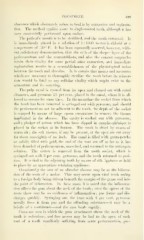Page 501 - My FlipBook
P. 501
TREATMENT. 499
abscesses which obstinately refuse to heal is by extraction and replanta-
tion. The method applies alone to single-rooted teeth, although it has
been successfully performed upon molars.
The patient's mouth is to be sterilized, and the tooth extracted. It
is immediately placed in a solution of 1 : 1000 mercuric chlorid at a
temperature of 120° F. It has been repeatedly asserted, however, with-
out satisfactory demonstration, that the cells of the deeper layer of the
pericementum and the cementoblasts, and also the cement corpuscles
retain their vitality for some period after extraction, and immediate
replantation results in a re-establishment of the physiological union
between the tooth and alveolus. It is certain that means and measures
which are necessary to thoroughly sterilize the tooth before its reinser-
tion Avould be fatal to any cellular vitality which might exist in the
cementum and its covering.
The pulp canal is opened from its apex and cleaned out with canal
cleansers, and pyrozone 25 per cent, placed in the canal, where it is al-
lowed to remain for some time. In the meantime the socket from which
the tooth has been removed is syringed out with pyrozone, and should
the pericementum not be adherent to the tooth, the depth of the socket
is scraped by means of large spoon excavators to remove the tissues
implicated in the abscess. The cavity is washed out with pyrozone,
and a pledget of cotton which has been dipped in campho-phenique is
placed in the socket at its bottom. The tooth is dried by means of
warm air ; the soft tissues, if any be present, at the apex are cut away
for about one-eighth of an inch. The canal is filled with gutta-percha
or solidly filled with gold, the end of the root cut off as far as it has
been denuded of pericementum, smoothed, and returned to the antiseptic
solution. The cotton is removed from the tooth socket, which is
syringed out with 3 per cent, pyrozone, and the tooth returned to posi-
tion. It is tied to the adjoining teeth by means of silk ligatures or held
in place by an appropriate retaining appliance.
0(!casionally the seat of an alveolar abscess may be at the l)ifurca-
tion of the roots of a molar. This may occur upon vital teeth owing
to a foreign body being driven beneath the margin of the gums and into
the point of bifurcation. In these cases it is noted that the inflamma-
tion affects the gum about the neck of the tooth ; over the apices of the
roots there may be no evidences of inflammation ; pus forms and dis-
charges quickly. Syringing out the tract with 3 per cent, pyrozone
usually frees it from pus and the offending substance—it may be a
bristle of a toothbrush—and the case heals rapidly.
Cases are seen in which the gum attachment about the neck of the
tooth is unbroken ; and free access may be had to the apex of each
root of a tooth manifestly sufl'ering from acute pericementitis, pre-


